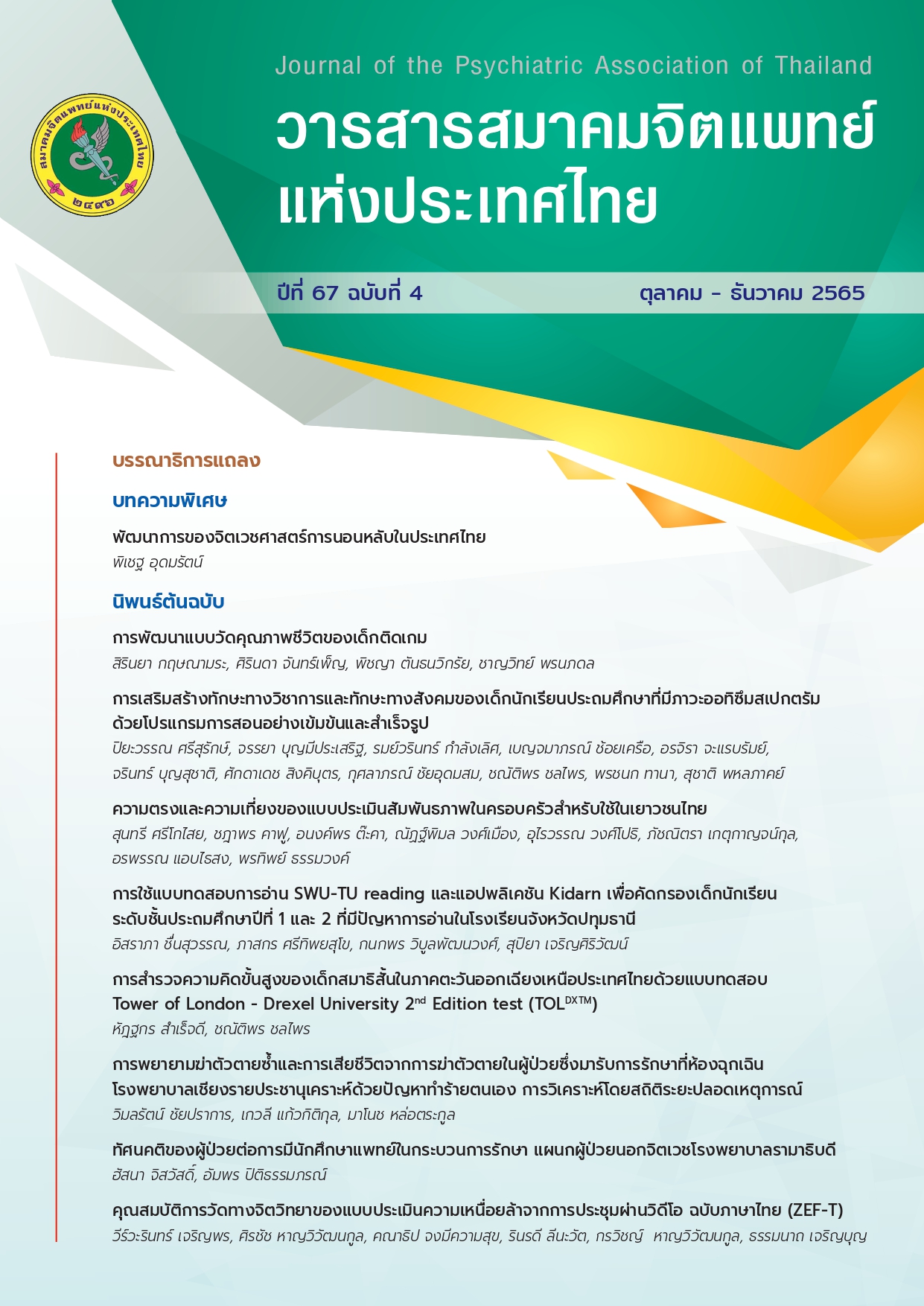Using the SWU-TU reading test and Kidarn application to screen for student grade 1 and 2 with reading difficulties in schools in the Pathum Thani province
Main Article Content
Abstract
Objective: To study using the SWU-TU reading tests and the Kidarn application to assess reading skills of students in primary schools located in Pathum Thani Province at grade1 and follow up at grade 2.
Methods: A longitudinal study was conducted to find the reading skills of students from grade 1 to grade 2. The SWU-TU reading tests were used to assess word reading, non-word reading, and passage reading. The Kidarn application was used to evaluate basic reading skills including letter-sound matching, phonological awareness (onset awareness), phoneme blending, and phoneme segmenting.
Results: A total of 1,024 students were tested in grade 1 and 876 received a follow-up test in grade 2. The results displayed that the scores of each subtest of the SWU-TU reading and Kidarn were not a normal distribution pattern in both grade 1 and grade 2 testing, and also revealed high distribution of data which shows that children have various reading abilities even they were in the same grade. The median (IQR) scores for word reading, non-word reading, and sum of passages reading were 11(6- 19), 9 (5- 14), 48 (17- 138) at grade 1, and 29 (15- 46), 14 (8- 24) and 255 (126- 324) at grade2 respectively. It was found that the letter-sound subtest of Kidarn revealed ceiling effect since grade 1; the median score is equal to the maximum score of the test. The median (IQR) scores of letter-sound correspondence, phonological awareness (onset awareness), phoneme blending, and phoneme segmenting of the Kidarn at grade 1 were 20 (18- 20), 9 (6- 13), 20 (16- 23) and 11 (7- 13) consequently, and at grade 2 were 20 (19- 20), 14 (9- 18), 22 (20- 24) and 13 (11-14) at grade 2 respectively. We proposed to use the cut-off point value at the 10th percentile as a dividing point for children in need of assistance.
Conclusion: The use of the SWU-TU reading and the Kidarn among students in Pathum Thani province, grade 1 and grade 2 showed that the scores had abnormal distribution patterns and high distribution.
Article Details

This work is licensed under a Creative Commons Attribution-NonCommercial-NoDerivatives 4.0 International License.
Articles submitted for consideration must not have been previously published or accepted for publication in any other journal, and must not be under review by any other journal.
References
Altarac M, Saroha E. Lifetime prevalence of learning disability among US children. Pediatrics. 2007;119 (Suppl 1):S77-83.
Katusic SK, Colligan RC, Barbaresi WJ, Schaid DJ, Jacobsen SJ. Incidence of reading disability in a population-based birth cohort, 1976-1982, Rochester, Minn. Mayo Clin Proc 2001;76(11):1081-92.
Roongpraiwan R, Ruangdaraganon N, Visudhiphan P, Santikul K. Prevalence and clinical characteristics of dyslexia in primary school students. J Med Assoc Thai 2002;85 (Suppl 4):S1097-103.
Areemit R, Suphakunpinyo C, Lumbiganon P. Sutra S. Thepsuthammarat K. Thailand’s adolescent health situation: Prevention is the key. J Med Assoc Thai 2012; 95 (Suppl 7):S51-8.
American Psychiatric Association. Diagnostic and Statistical Manual of Mental Disorders. 5 ed. Arlington, VA: American Psychiatric Publishing; 2013.
National reading panel, teaching children to read: An evidence-based assessment of scientific research literature on reading and its implication for reading instruction report of the subgroup [Internet]. 2000. [Access 2 January, 2022]. Available from: https://www.nichd.nih.gov/sites/default/files/publications/pubs/nrp/Documents/report.pdf
Early Grade Reading Assessment (EGRA) Toolkit: second edition [Internet]. 2016. [Access 2 January, 2020]. Available from: https://pdf.usaid.gov/pdf_docs/PA00M4TN.pdf
Munzer T, Hussain K, Soares N. Dyslexia: neurobiology, clinical features, evaluation and management. Transl Pediatr 2020;9(Suppl 1):S36-s45.
Russell G, Ryder D, Norwich B, Ford T. Behavioural difficulties that co-occur with specific word reading difficulties: A UK population-based cohort study. Dyslexia. 2015;21(2):123-41.
Arnold EM, Goldston DB, Walsh AK, Reboussin BA, Daniel SS, Hickman E, et al. Severity of emotional and behavioral problems among poor and typical readers. J Abnorm Child Psychol 2005;33(2):205-17.
Snowling MJ. Early identification and interventions for dyslexia: a contemporary view. J Res Spec Educ Needs 2013;13(1):7-14.
Lipkin PH, Okamoto JK. The Individuals with Disabilities Education Act (IDEA) for children with special educational needs. Pediatrics 2015;136: e1650-e1662.
Fletcher JM, Francis DJ, Morris RD, Lyon GR. Evidence-based assessment of learning disabilities in children and adolescents. J Clin Child Adolesc Psychol 2005;34(3):506-22.
Hulme C, Snowling MJ. Children's reading comprehension difficulties: Nature, causes, and treatments. Curr Dir Psychol Sci 2011;20(3):139-42.
Melby-Lervåg M, Lyster SA, Hulme C. Phonological skills and their role in learning to read: A meta-analytic review. Psychol Bull 2012;138(2):322-52.
Vibulpatanavong K, Evans D. Phonological awareness and reading in Thai children. Reading and Writing. 2019;32:1-25.
Lonigan CJ, Shanahan T. Developing early literacy skills: Things we know we know and things we know we don't know. Educ Res 2010;39(4):340-6.
McArthur G, Sheehan Y, Badcock NA, Francis DA, Wang HC, Kohnen S, et al. Phonics training for English-speaking poor readers. Cochrane Database Syst Rev 2018;11(11): Cd009115.
Chunsuwan I, Vibulpathnavong K, Charoensiriwath S, Peethong A. Using Kidarn Application to assess Thai early reading skills: Evaluating validity and reliability. Asia Pacific Journal of Developmental Differences. 2020;7(2):265-80.
วิกิพีเดีย. รายชื่อโรงเรียนในจังหวัดปทุมธานี [internet]. 2563. [Access 2 January, 2022] Available from: https://th.wikipedia.org/wiki/%E0%B8%A3%E0%B8%B2%E0%B8%A2%E0%B8%8A%E0%B8%B7%E0%B9%88%E0%B8%AD%
Vibuplatanavong K ED. Off to a Good Start: Enhancing reading skills in Thai Children. The First International Conference on Special Education. Bangkok; 2015. p. 28-31.
Raven J. The Raven Progressive Matrices: A review of national norming studies and ethnic and socioeconomic variation within the United States. J Educ Meas 2005;26:1-16
Phattharayuttawat S, Sukhatunga K, Chantra J, Chaiyasit W, Bunnagulrote K, Imaroonrak S. The normative score of the Standard Progressive Matrices for the Thai Population. J Psychiatr Assoc Thailand 2000; 45(1): 45-57.
สำนักงานสถิติแห่งชาติ. สรุปผลที่สำคัญการสำรวจสภาวะเศรษฐกิจและสังคมของครัวเรือนในช่วง 6 เดือนแรกของปี 2562 [internet]. กรุงเทพฯ: บริษัท ธนอรุณการพิมพ์ จำกัด; 2562. [Access 2 January, 2022]. 42p. Available from: http://www.nso.go.th/sites/2014/DocLib13/Exclusive_summary_62.pdf
สำนักงานเลขาธิการสภาการศึกษา. ปีการศึกษาเฉลี่ยของประชากรไทย ปี 2561 [internet]. กรุงเทพฯ: บริษัท พริกหวานกราฟฟิค จำกัด; 2562. [Access 2 January, 2022]. 107p. Available from: https://fliphtml5.com/wbpvz/whwi/basic


